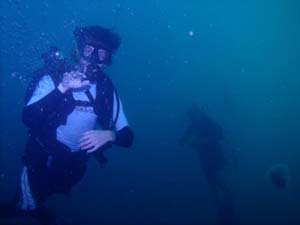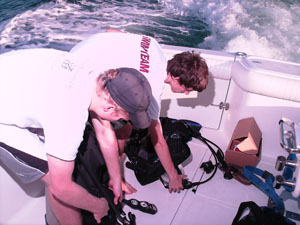HISTORY OF NWF NaGISA
The history of the NaGISA project in Northwest Florida starts in the summer of 2003. Having been involved in the Fulbright Memorial Fund (FMF) Teacher Program (now the Japan Fulbright Memorial Fund), Richard A. Hernandez, the Teacher of the Gifted from Niceville High School, applied for and was accepted by the FMF Master Teacher Program. This is a program that establishes a collaborative relationship between schools in Japan and counterpart schools in the United States. Niceville High School was paired with the Wakayama Prefectural Tanabe Commercial High School. During the summer, the United States traveling teacher visits and works in the Japanese school for four weeks. It was during thistimeframe, in July 2003, that Mr. Hernandez was taken on a tour of the area surrounding the City of Tanabe. One stop was at the Seto Marine Biological Research Laboratory of Kyoto University. He was given a thorough tour of this facility by the director, Dr. Yoshihisa Shirayama.
Upon the conclusion of the tour, Dr. Shirayama, Mr. Hernandez and Takamasa Yamamoto, the Vice-Principal of the Tanabe Commercial High School, discussed the NaGISA project. It was during this discussion that Dr. Shirayama invited Niceville High School to participate in the project. The invitation was based on the fact that the project was on such a massive scale; it would be very difficult for universities alone to adequately survey the entire coast line of the planet. Participation by high schools would also permit students to have an opportunity to not only be involved in an extremely worthwhile project, but also be exposed to real world science and collection techniques so they might see some of the practical applications of the concepts which until then had only been theories and lectures in the classroom. On behalf of Niceville High School, Mr. Hernandez accepted the offer.
As a result, NaGISA NW Florida became a test case to see if a high school would have the ability to interpret the NaGISA protocol, amass the expertise and equipment necessary to do a collection and analysis, and train the students sufficiently to ensure everything was accomplished at a standard that was acceptable at the international science research level. In July 2004, the FMF again provided assistance by creating a special program in which high school students and teacher from the United States exchanged with students and teachers from a high school in Japan. Niceville High School and Tanabe Commercial High School were chosen for this pilot project of the Fulbright Memorial Fund Collaborative School Science Network (FMF CSSN). The special collaborative project chosen for this pilot program was NaGISA. Five students and two teachers traveled to the Seto Marine Biological Research Laboratory in Shirahama, Japan where they were given personal instruction by Dr. Shirayama and his staff on collection and analysis techniques associated with the NaGISA project.
In October 2004, five students and two teachers from the Tananbe Commercial High School traveled to work with the students and faculty at Niceville High School. During that visit, they participated in a NaGISA collection and analysis at the NaGISA NW Florida collection site. From the beginning, Niceville High School has worked very hard to learn everything possible about the NaGISA program and has taken steps to improve collection and analysis procedures with each collection. The program now has expanded to include two more high schools on the north Florida coast. After three years of collection and analysis, refinements of technique and training, the results are conclusive that with the right relationship with a sponsoring university, high schools can effectively be a part of the NaGISA project and take their place with university level researchers.


